Highlights
Oh the joys of May. A month where it feels like
anything can happen and the potential for a patch mega or even a county level
rarity reaches its peak levels of anticipation. A reminder of what can
occasionally happen came just across the border in Buckinghamshire when a
scarcely believable record of an Alpine Accentor at Pitstone Quarry came
on the 5th May. Being a mere 13 miles away was sufficient to see
plenty of Oxon birders make the short journey across to Bucks, a
record that continues to prove the old adage that anything can turn up
anywhere! Although not quite on the same level, the county did record its very
own local mega when a Grey-headed Wagtail was picked up on Port
Meadow on the 3rd May. A female bird, a proper birders
bird at that, came almost to the day of the last record back on the 1st
May 2019 on the same site, even more remarkable was that both these most
recent records were found by the same birder. Being the fourth record for the
county, the same birder is now responsible for 50% of the county’s records for
this species – some feat! Unfortunately, like the previous record, this bird
was only present into the evening before departing that night. The county has
been lucky enough to host four subspecies of Yellow Wagtail with two
turning up on near regular basis, below is a summary of the records for Oxon.
Some distant video footage of the Port Meadow bird this month courtesy of Steve Lavington
Channel Wagtail
The hybrid offspring of the nominate Flava and our
very own native Flavissima – a result of an intergrade breeding zone in
Northern France. It is the most common of the Yellow Wagtail forms to
occur in the county, aside from Flavissima that is, and had been
recorded on a near annual basis up until 2021, but it has now been several
years since then with no records. The spring of 2021 appeared to be a
particularly good year for records where four birds were recorded across four
different sites.
 |
| Courtesy of Ewan Urquhart. |
Blue-headed Wagtail
The nominate
subspecies Flava is also a semi-regular occurring subspecies within the
county with records following a similar pattern that of the Channel Wagtail,
occurring on an a near annual basis up until 2021. Although records are
occasionally mixed up between the hybrid Channel’s and nominate Blue-headed
both did occur in the county in 2021 in what was a good year for both
forms. 2024 saw a single record of 3 females on Port Meadow at the back
end of May, after an absence of three years.
 |
| Above & below courtesy of Thomas Miller. |
Grey-headed Wagtail
The Scandinavian subspecies breeding from northern
Scandinavia through to north-western Siberia occurs in the UK on annual basis
in small numbers. Typically these records come much later in the year than
those of Flava forms with the birds migrating much further north. The
county has been lucky to play host to four birds, two of which have come in the
last 5 years. The 1st and 2nd record were of a pair of
birds on the Oxon Downs in 1992, but details are scant regarding length
of stay and/or sex of the birds. However, nearly 30 years later, a stunning
male graced Port Meadow on the evening of the 1st May 2019.
Unfortunately a one day wonder, although thankfully found early enough for
others to connect – a very similar pattern followed by the next record in 2024.
This bird’s identification proved a little trickier than the male of 2019, for
obvious reasons. Although likely a female thunbergi, particularly based
on timings and the UK wide influx of the subspecies – three males arrived on
the east coast also on the 3rd May, the influence of flava,
iberiae or cinerocapilla cannot be ruled out in this bird.
 |
| Above courtesy of Jason Coppock – 2019 |
Black-headed Wagtail
The rarest of the four subspecies or forms to have occurred
in the county and the big prize for most birders when it comes to finding rarer
Yellow Wagtails. The UK had only had fewer than 20 records of feldegg
up until 2010 before a big uptick in records in the last decade and a half. One
of those records pre-2010 was from our very own county where a stonking male
was observed holding territory in Brightwell-cum-Sotwell in June 1988.
Apparently very aggressive and instigating mid-flight duels with local flavissima,
this bird was never observed to be properly paired up despite its best
efforts. This record was made even more interesting when in the same exact
field that year, a male flava paired with up with a female flavissima
fledging three young!
 |
| Ian Lewingtons fantastic feldegg sketch |
Thomas Miller, the finder of both of the county’s latest Grey-headed
Wagtail records, has helpfully provided some additional ID info on
distinguishing female flava and thunbergi been somewhat of Yellow
Wagtail subspecies enthusiast and all round ID expert.
Female flava
1. Blue-grey head contrasting with mantle.
2. Darker lores than flavissima.
3. White throat, supericilium and ear-covert spot – typically
yellow in flavissima.
4. Buzzy call.
Female thunbergi
1. Very dark grey head and lores, some overlap with flava.
2. Reduced supercilium – thinner than flava, not flaring behind
the eye.
3. Reduced ear covert spot.
4. Often has whitish throat/supercilium, but some individuals
more yellow.
5. Often has dark marks/streaking in a “necklace”
shape extending onto chest below throat – also present in male thunbergi.
6. Has buzzy call like flava – may be separable from flava
using sonogram
As in previous years we will be taking a small break over the
summer lull but will be back at the end of July to round up any notable
sightings that may have happened over the summer. The county year list now has
ticked up to 177, despite me saying it was 183 in the last review which
included subspecies, ferals and probable records. With those included it now
stands at 193 with a small flurry of cracking subspecies recorded this month
and a couple unconfirmed probable’s.
Waders
An expectedly busy month for wader records, with plenty of
interesting species moving through the county. The main highlight came in the
early part of the month when a pair of Avocet turned up at Peep-o-Day
Lane on the 6th. Quite a late record with most birds already on
nests around the country, there was some brief hope that these birds would set
up shop in the county when the birds remained for a couple of days after.
Unfortunately, the birds departed by the 10th, despite behaving
territorially in the time they were here.
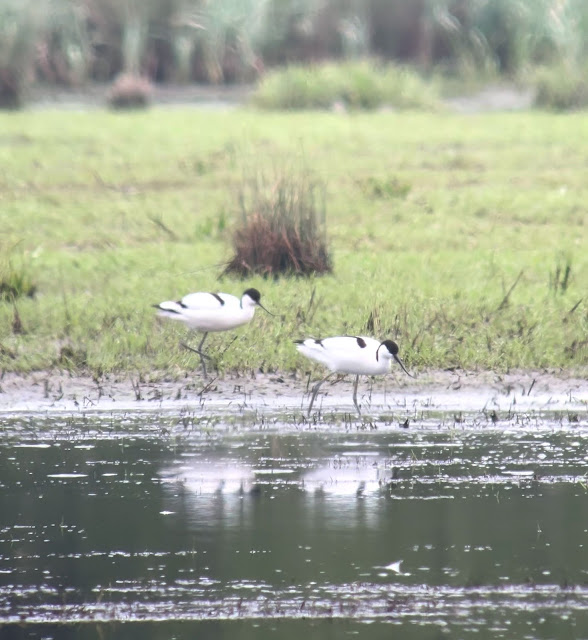 |
| courtesy of Steve Sansom |
Sanderling had a good showing
this month, with records from the 4th all they way through to the 26th.
A classic bird of late spring, with birds heading as far north as Greenland,
the first bird arrived on the 4th. This was followed by two on
the 11th which seemingly remained until the 17th. A nice
flock of five were present on the 22nd in inclement weather, with
between two and four still present until the 26th.
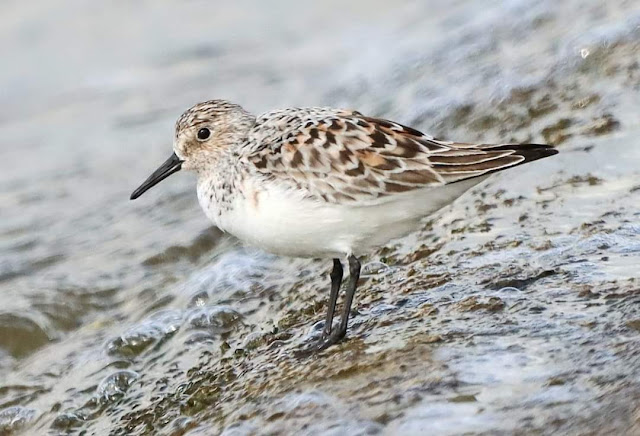 |
| courtesy of Debbie Cummins |
Turnstone were present on Farmoor in the latter part of the
month, arriving initially inclement weather along with the Greenland bound
Sanderling and arctica Dunlin. A pair of birds was present
on the 22nd until the 25th. A probable 2nd
pair of birds was then present on Farmoor on the 30th. Whimbrel
records only came from the early part of the month with two sites recording
birds on the 4th of the month – three birds on the Farmoor and
a single bird on Pit 60, whilst Greenshank were also present at
two sites at Farmoor on the 4th and Waterstock on the
11th. Dunlin records calmed somewhat in May, although
four sites still hosted birds. Farmoor, Port Meadow, Ardley and Venn
Mill with only singles at the latter two. Farmoor saw the most birds
where up to 13 were present on the 27th, but most interestingly were
two to three strong candidates for the arctica subspecies. With only a
handful of good candidates in the last two decades – birds are typically paler,
smaller and shorter billed birds classically arriving in late May and
are potentially on route Greenland. A thorough blog post on arctica in
North Spain can be found here – https://subalpinebirding.com/blog/greenland-dunlin-ssp-arctica-a-first-approach-to-its-identification
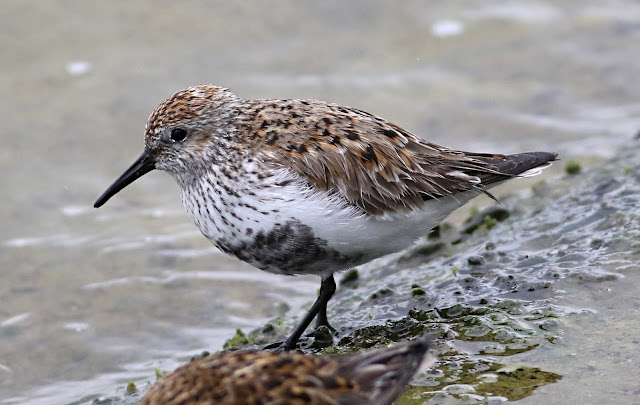 |
| Above and below, the candidate arctica courtesy of Ian Lewington |
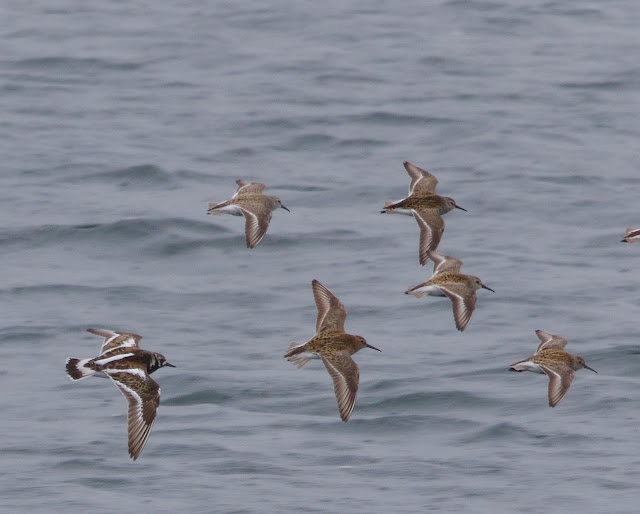 |
| …the top left bird |
Courtesy of Ben Sheldon
A Grey Plover was reported but unconfirmed from Otmoor
on the 12th, whilst a beauty of a Wood Sandpiper came
from Widford on the 19th although unfortunately it didn’t
linger long enough for others to connect beyond the single day.
courtesy of Mick Cunningham
Black-tailed
Godwit records were limited to the early part of the month and to only single
birds at two sites – Port Meadow on the 4th and Days Lock on
the 8th. Ringed Plover records also tailed off with only three
sites seeing birds recorded, with all hosting multiple birds. Port Meadow recorded
five on the 9th with a single there on the 25th. Balscote
Quarry played host to three birds on the 14th, whilst Farmoor
had two on the 7th. Common Sandpiper continued to move through
the county in small numbers, presumably a mix of non-breeders and birds moving
further north, with five sites recording birds. Henley Road, Grimsbury,
Farmoor and Oxford all recorded birds in the early part of the month
whilst Farmoor, Grimsbury and Port Meadow recorded multiple birds
together in the latter stages of May.
Wildfowl & Game etc
The year’s first Quail was right on que with the arrival
of a duo of singing birds at Chipping Norton on the 12th. This
was swiftly followed by a single singing bird at Toot Baldon on the 16th,
which was still singing on 19th. Presumably June will bring
with it more singing birds along the various cereal fields of the Downs,
certainly worth an early rise if you get a chance to.
Garganey were at five locations this month with some encouraging signs, due to
lateness of the records and length of stay, that some local breeding may occur
again. Records all came from the north and west of the county with all records
been single drakes or pairs. A rather late record of White-fronted Goose came
from Otmoor on the 15th with two birds here, although these
may relate to the feral birds that frequent the county all year round as opposed
to the Russian birds that spent much of the winter on site.
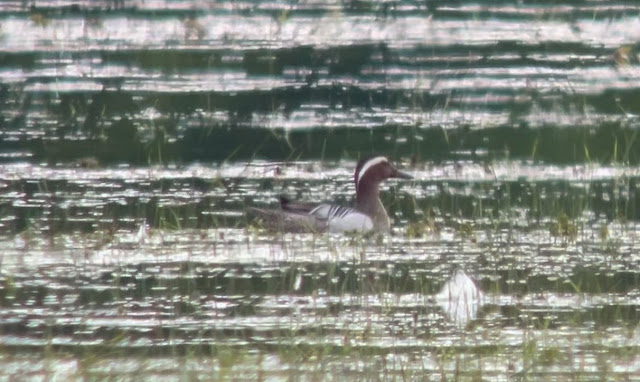 |
| The Port Meadow Garganey courtesy of Steve Sansom |
Some great news of breeding Shelduck came from two sites
this year. A rare breeding bird in the county, its fantastic that two pairs
have bred at Days Lock and Venn Mill. At the former the pair were
first observed on the March 16th with the male behaving very
territorially from the off before the female disappeared a month later. By May
20th the pair had returned to the new scrape on the Earth
Trust land with 10 fresh ducklings having seemingly swam down river from
their nesting location. A further three
sites hosted birds this month, with Port Meadow recording 11 birds on
the 28th, with the prevalence of so many birds well into the breeding
season it seems maybe more breeding records may be on the cards.
 |
| Shelduck family courtesy of Geoff Wyatt. |
Herons, egrets etc
In what might have been a contender for the highlght of the
month, if not for a
certain Grey-headed Wagtail at the same site earlier in the month, a juvenile Spoonbill
was present on Port Meadow on the 22nd. This record was made
even more interesting by the fact that it was colour ringed from a ringing
scheme in Denmark! Ringed as a chick in Hoje Sande, Ringkobing Fjord
in June 2023 the bird spent the winter on the Hayle Estuary, Cornwall
with a small jaunt to Yorkshire in between. A brilliant record and
amazing to be able to trace this birds movements since leaving its native Denmark.
The bird was gone by the following day and has hopefully made its way north
back to its homeland.
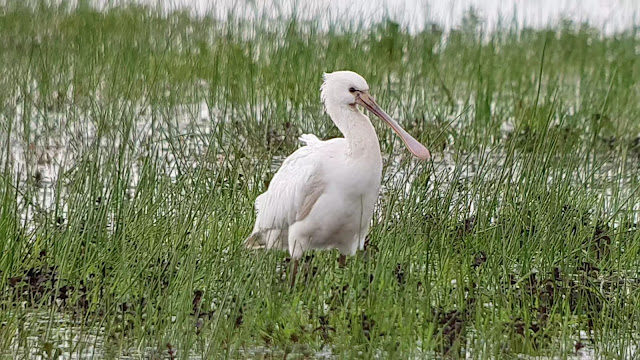 |
| courtesy of Thomas Miller |
Another decent bird to grace the county this month was a Glossy
Ibis which turned up at Otmoor on the 4th. The bird remained
here until the 6th before then also visiting Port Meadow on
the same day, a site which has had a particularly good late Spring. The
bird then went missing and was assumed to have departed the county. A 2nd bird was seen then on the 17th again at Otmoor and was
present on and off again between then and the 27th, with a brief
sighting at Port Meadow on the 24th and at Clifton Hampden on the 25th.
 |
| Glossy Ibis Otmoor rspb courtesy of Kyle Smith. |
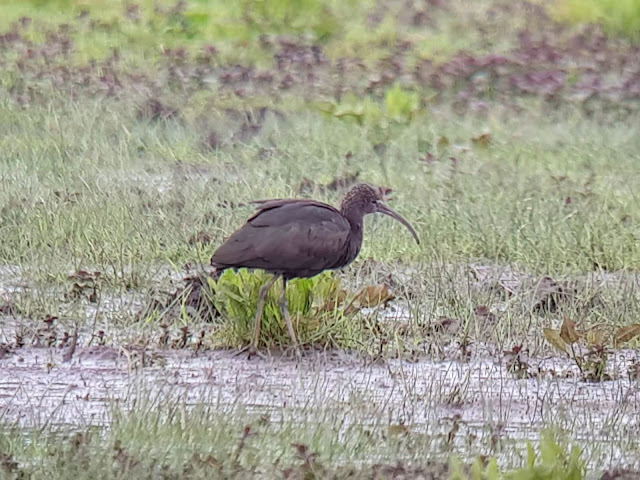 |
| The Port Meadow bird courtesy of Thomas Miller |
More White Stork records
were observed this month where a presumed Knepp Estate ringed bird was
observed flying over several locations in the county on the 11th. An
apparently un-ringed bird was also then present at Waterstock the
following day with several birds frequenting this area over the last couple of
months.
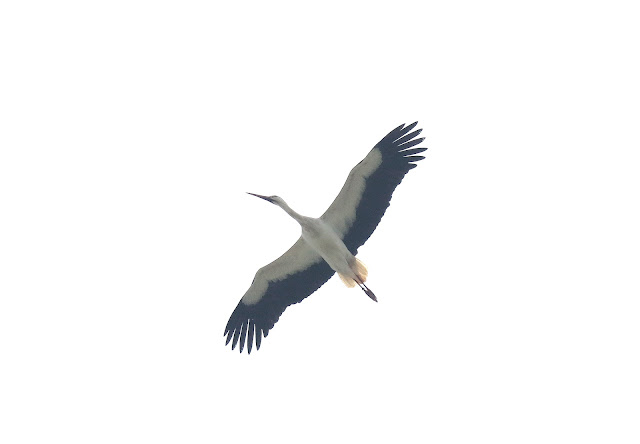 |
| Courtesy of Wayne Paes |
Cattle Egret continued their typical pattern of this time of year with all
records coming from northern and western parts of the county, anywhere within
commuting distance of their breeding colony at Blenheim. The highest
count, aside from there, came from Shipton-on-Cherwell where six birds
were present on the 24th, whilst a further seven sites recorded
between one and two birds throughout the month. Great Egret records dissipated
a bit more this month, although up to six birds seemed to be present in the
county at any one time. A maximum of four were at Pit 60 on the 4th
whilst a pair were frequented Otmoor through the month. At least two
birds were seen in summer plumage, could this be the year?
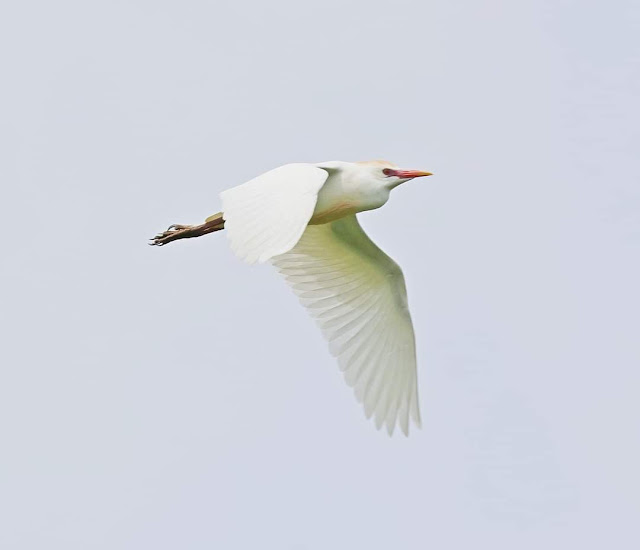 |
| Otmoor Cattle Egret courtesy of Steve Cumnock |
Gulls and Terns
May was all about quality over quantity for
Gull and Tern records. Otmoor got its, and the county’s, 2nd
Little Tern of the year only two weeks after the first one at the end of
last month. Both these records come after an absence the previous year, but
unfortunately both were brief records unlike the 2022 bird which stuck around
for several day across Port Meadow and Farmoor. The county also
saw its first Black Tern of the year with a small flock of eight birds on
Farmoor on the 11th, it’s always a wonderful spectacle to see
this species darting and bouncing around the reservoir whilst on active migration!
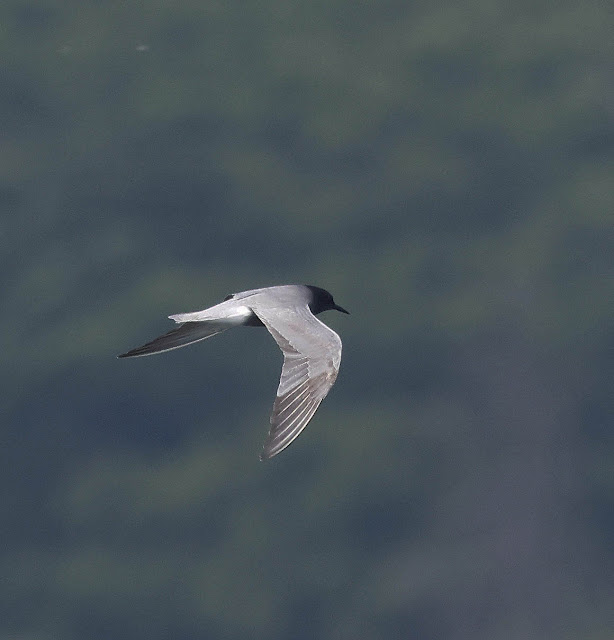 |
| courtesy of Ewan Urquhart |
The early part of the month also saw more
records Sandwich and Arctic Tern. Rushy Fen had a single Sandwich
Tern on the 1st of the month, followed up by a cracking record
of multiple birds on the 7th where four graced the same site. The 3rd
saw yet more Arctic Tern moving through the county across multiple sites.
Grimsbury Reservoir saw 2+ birds come and go fairly quickly, as records tend
to at this site, whilst Dorchester Sailing Club had at least three birds
pass through. Farmoor initially hosted a few birds on the morning of the
3rd which slowly increased to 20+ as the day went on in what
appeared to be one last big movement of birds across the country. No birds remained
at any sites the following day.
Lingering winter gulls remained in
the county all the way through to the end of the month, in what has become a
later and later pattern in recent years. A 1st summer Caspian
Gull was initially at Shepherds Pit north of Oxford on the 14th,
which then appeared at Port Meadow on the 25th. Whilst an adult
Yellow-legged Gull was at Sonning Eye GPs on the 7th.
Passerines
A quiet month for rarer and migrant passerines with the big
push of birds occurring in the previous month. The main highlight for the month
was a stonking male Black Redstart on residential street in Bicester on
the 2nd. Unfortunately like the previous records this year it was untwitchable
and not located the despite searching. A lone Whinchat record came from Otmoor
on the 9th whilst several Wheatear likely bound for Greenland
were at Farmoor on the 7th and Yarnton on the 14th ,
with the Farmoor bird been a particularly good candidate.
In rarer Motacilla news Farmoor hosted a single
White Wagtail record on the 3rd, whilst three female Blue-headed
Wagtail were present on Port Meadow on the 3rd following off
the back of the subtle female thunbergi type Yellow Wagtail also
present here on the 3rd.
 |
| Cuckoo Otmoor rspb courtesy of Kyle Smith. |
Raptors
A
wholly unconfirmed report of a Black Kite over Otmoor came on the
15th of the month, unfortunately the reporter was not pinned down
for any additional details so this one will remain a mystery. The same applies
for an unconfirmed report of a Honey Buzzard over Weston-on-the-Green
on the 23rd. Short-eared Owl, however, continue to linger
in the county at several sites with a strong hope that some birds may eventually
breed in the county.
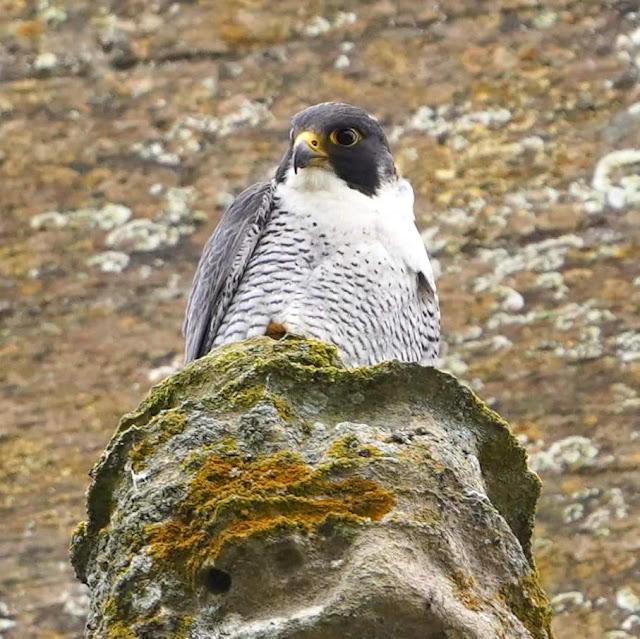 |
| Peregrine St Marys Witney Courtesy of Andrew Hall |
Hobby were
present in good numbers at Otmoor through the month with a brilliant high
count 17 here on the 4th. Marsh Harrier were noted at a few
locations from the usual site of Otmoor with five sites recording birds.
Appleford GPs and Bicester Wetlands were particularly unusual
given the time of year with a pair seen in the west of the county over Witney,
Ducklington and Rushy Common were perhaps more usual locations given
the proximity to Pit 60 and Chimney Meadows.
Patchwork challenge
|
Patch |
Birder |
Points |
Species |
Highlight |
|
Aston eyot |
Ben Sheldon |
71 |
70 |
Reed Warbler – patch tick |
|
Ardley ERF |
Gareth Casburn |
84 |
79 |
Dunlin and Red-crested Pochard |
|
Dix pit |
Simon Bradfield |
77 |
71 |
|
|
Grimsbury reservoir |
Gareth Blockley |
70 |
73 |
|
|
Lye valley |
Tom Bedford |
58 |
57 |
|
|
River Thames |
Geoff Wyatt |
155 |
130 |
|
|
Sutton Courtenay |
Conor MacKenzie |
123 |
111 |
Avocet and Marsh Harrier only the 2nd |
|
Radley GP’s |
Ian Elkins |
112 |
101 |
|
|
Freeland |
Glen Pascoe |
76 |
65 |
|
|
South Hinksey |
Alex Figueiredo |
61 |
59 |
Cuckoo |
|
Cholsey |
Alan Dawson |
106 |
100 |
Firecrest |
 |
| Hobby hunting on Otmoor composite Courtesy of Joe Downing. |
Treecreepers.
Terry Godfrey filmed a pair of nesting Treecreepers (from a safe distance) in his Cassington garden.
Below is a beautiful compilation of their progress.



